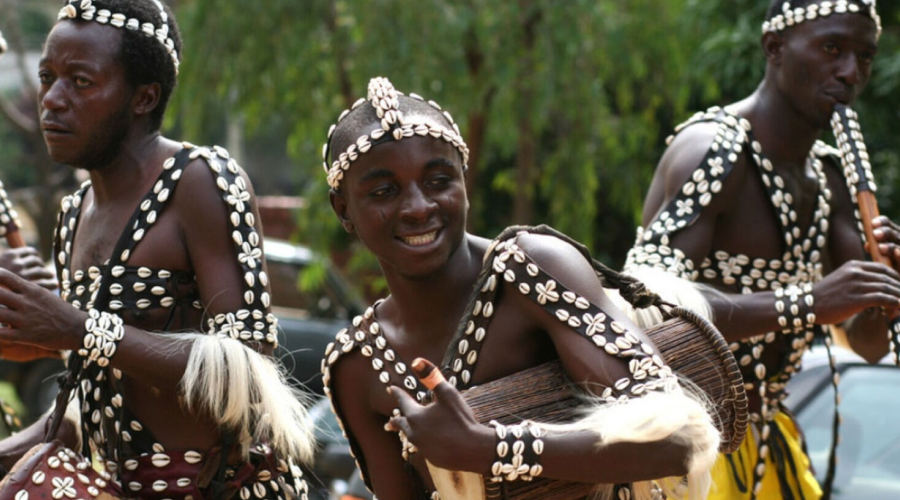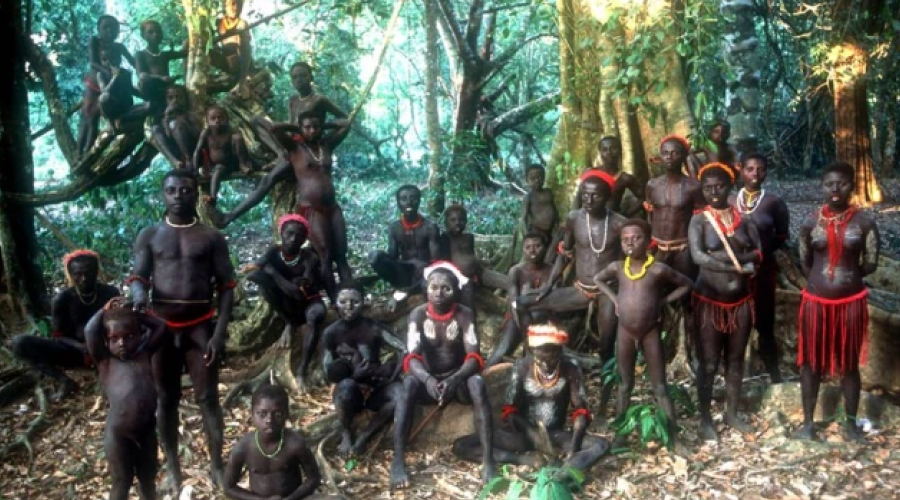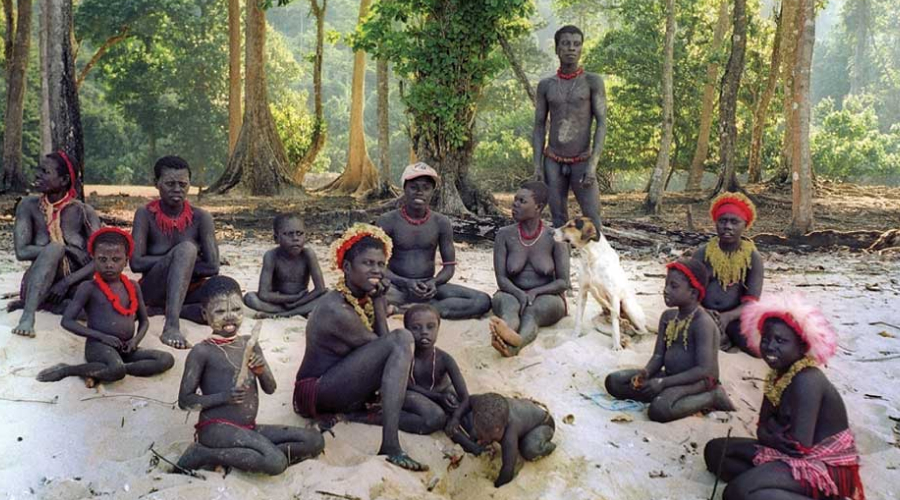Nestled in the southeastern part of Asia, the Andaman and Nicobar Islands act as a bridge between the vast Bay of Bengal and the shimmering Andaman Sea. These islands aren’t just another tropical paradise; they’re a significant chapter in the diverse geographical tapestry of India. With shimmering beaches, lush forests, and a breathtaking marine ecosystem, the islands are a coveted destination for travellers from around the world.
Suggested Read: Trekking in Andaman and Scuba diving in Andaman
However, the essence of Andaman and Nicobar isn’t just in its scenic beauty or diverse flora and fauna. The heartbeat of these islands lies in its indigenous tribal groups. They’re the first inhabitants, who’ve been residing here, long before tales of modern civilization touched the shores. Their life is a poignant reflection of the human race’s earliest ways of life. They rely primarily on hunting and gathering, coexisting in harmony with nature, and remaining largely untainted by external influences.
These tribal communities are a window into our past, a reflection of the primordial roots of human existence. Their customs, rituals, and way of life are intriguing and inspire curiosity. So, let’s dive deeper and explore the rich history, origin, and the contemporary status of these tribes, to understand them beyond the exotic tales and truly appreciate their unique place in the world.
The Mongoloid and Negrito Tribes of Andaman Islands
Within the verdant landscapes of the Andaman and Nicobar Islands are the ancient tales of its inhabitants, primarily distinguished into two main tribal categories: “the Negritos” and the “Mongoloids”. Let’s explore further into the intricate stories of these tribal groups.
Origins and Arrival:
Negritos: Hailing from African ancestry, the Negritos are believed to have made their journey to the Andaman Islands some 60,000 years ago, establishing themselves as the earliest settlers of this pristine land. With dark skin and curly hair, their genetic blueprint is reminiscent of their African origins.
Mongoloids: The Mongoloid tribes, characterised by their Mongolian features, are believed to have journeyed to the islands from the coasts of Malay-Burma, settling here several millennia ago.
The Negrito Tribes of Andaman:

1. The Great Andamanese Tribe:
The Great Andamanese Tribe stands as one of the original inhabitants of the Andaman Islands. Once a thriving community with numbers in the thousands, they fiercely guarded their homeland from intruders. Any foreign presence was met with intense hostility, ensuring their culture remained untainted for generations.
However, the arrival of the British in the 19th century ensued a tragic era. In the face of modern weaponry and unfamiliar diseases, their population witnessed a catastrophic decline. From thousands, their numbers plunged to a mere 44 by the early 2000s.
Today, this community is no longer nomadic. Settled on Strait Island by the Andaman & Nicobar Administration, they have homes and coconut plantations for their livelihood. The Andaman administration also provides them with essential supplies, including clothing and food. However, remnants of their ancestral practices can still be seen, as they occasionally go out hunting and fishing.
For those journeying to the Andaman Islands, a visit to the Marina Park is recommended. Here stands a statue commemorating the bravery of Andamanese warriors, a silent witness to their resilience and the earliest struggles for freedom.
2. The Onge Tribe:
The Onges, another vibrant tribal group from the Negrito category, are semi-nomadic residents of the Andaman Islands. Originally from Dugong Creek on Little Andaman Island, they’ve always been closely connected to nature, relying on its bounty for sustenance.
Like their Andamanese counterparts, the Onges too faced a harsh decline during the British era. By the early 2000s, only 96 members were recorded.
In the present day, the Onges have begun interacting more openly with other locals. They are beneficiaries of medical care, housing, schooling, and other amenities, thanks to the efforts of the Andaman administration. While they partake in coconut plantations, their ancient instincts sometimes call them back to the wild, where they hunt, fish, and gather.
Their artistry is evident in their handmade canoes. And with the combined efforts of the Administration and local populace, hope is kindled for the stability and growth of the Onge community.
In essence, the tribal tapestry of Andaman is rich and diverse. While time has brought numerous challenges, the indomitable spirit of these tribes continues to inspire and captivate those fortunate enough to witness their tales.
3. The Jarawa Tribe:
One of the original inhabitants of the Andaman archipelago, the Jarawas have a legacy that is as old as time. Historically, they have been elusive, maintaining a guarded distance from outsiders, a practice that helped them in preserving their distinct culture and lifestyle.
Over time, a more welcoming stance has emerged within the Jarawas, a testament to the positive outreach programmes initiated by the Indian government. The 1974 contact expedition is a watershed moment in the history of the tribe, as it marked the first time the Jarawas shed their hostility towards an outside contact group.
Today, they number around 400, and in their nomadic existence, they live harmoniously with nature. Residing in groups, they thrive in chaddhas – a term they use for their homes. Their sustenance is derived primarily from the local fauna and flora; they are skilled hunters, using bows and arrows to catch pigs, turtles, crabs, and a variety of fish. The local forests offer them fruits, tubers, roots, and honey.
However, their existence has faced challenges, especially with the introduction of the trunk road in the 1990s. This road, slicing through their territory, inadvertently exposed them to outsiders, often with adverse consequences. The Jarawas’ limited immunity to foreign diseases remains a grave concern, further compounded by the influx of visitors.
4. The Sentinelese Tribe:
North Sentinel Island is home to one of the most enigmatic tribes in the world – the Sentinelese infamous for their hostility. This tribe remains an enigma, steadfast in its commitment to isolation. Their fierce desire for privacy and their intolerance to outside intrusion is noteworthy. Predominantly hunters and gatherers, the Sentinelese are believed to be heavily reliant on the sea, particularly mud crabs and various molluscs.
Despite the Andaman administration’s repeated attempts to establish contact, the Sentinelese remain unapproachable, often resorting to hostility to preserve their seclusion. A memorable instance took place in 1991 when the administration achieved a rare friendly contact on a Contact Expedition. Nevertheless, their general distrust of outsiders remains unchanged, evidenced by incidents like the tragic end of American Christian Missionary John Chau in 2018.
The Indian government, respecting their choice of isolation, has implemented policies to protect their privacy. The North Sentinel Island remains off-limits, safeguarded under the Aboriginal Tribes Act of 1956. As per the last census in 2001, the Sentinelese population was estimated to be 39.
The Mongoloid Tribals Andaman: Shompens and Nicobarese Tribes

1. The Shompens:
Located in the picturesque Great Nicobar Island, the Shompens have carved a niche for themselves in the rich landscape of the Andaman and Nicobar archipelago. These semi-nomadic people, believed to be first discovered by the Danish Admiral Steen Bille, have a lifestyle that is closely knitted with nature.
Their diet is an interesting mix of nature’s bounties: from yams, fruits, and roots and vegetables, they hunt, such as pigs and birds. The tropical environment of the islands dictates their attire. Men are often seen in short loincloths made of bark cloth, while women adorn knee-length skirts and occasionally, a shawl – all made from the same material. Their penchant for body adornment is evident in their bamboo earplugs, bead necklaces, and bamboo armbands. The Shompens, though not tech-savvy by modern standards, boast an array of traditional tools like spears, fire drills, and hatchets.
However, the tranquillity of their lives is now under threat from the ambitious “Great Nicobar Project”, which envisages large-scale development of the island. With nearly half of the project area impinging on the Tribal Reserve, and a surge in the population expected, the very essence of the Shompens’ existence is at stake.
2. The Nicobarese Tribe:
The shimmering waters of the Nicobar archipelago is home to the vibrant Nicobarese community. These Mongoloid tribes have entrenched themselves predominantly across the Nicobar Islands, with a lifestyle deeply rooted in agri-horticulture, pig rearing, and fishing. Their lush green surroundings allow them to cultivate coconuts, pandanus, areca nut palms, and an assortment of fruits, creating a monetary lifeline.
While they may not be the first inhabitants, cohabiting the islands with the earlier-settled Shompen, their cultural imprint is unmistakable. The world, through their eyes, is a mosaic of spirits – be it of living entities, elements of nature, or even mundane objects which is reflective in their artistry.
Adding a unique feather to their cap is their matrilineal societal structure. Matriarchs steer the tribe, and gender equality is not just an ideal but a lived reality. Men and women walk side by side, both in responsibility and stature. A stroll through their settlements would reveal huts, scattered yet organised, with their distinct round shape and dome-like roofs.
In essence, these tribes are not mere groups of individuals; they are living relics of ancient civilisations, carrying the weight of traditions that are thousands of years old. Their stories, while shadowed in mystery, offer a rare glimpse into the early tapestries of human civilization. In a world racing towards modernisation, these tribes offer a refreshing pause – a reminder of a time when life was harmoniously intertwined with nature.
FAQs about Tribes of Andaman and Nicobar Islands
Q1: How many tribes are there in Andaman?
There are six main tribes in the Andaman Islands: the Great Andamanese, Onge, Jarawa, Sentinelese, Shompens, and Nicobarese.
Q2: What are the four tribes of Andaman?
The four primary tribes of the Andaman Islands are the Great Andamanese, Onge, Jarawa, and Sentinelese.
Q3: Which is the friendly tribe of Andaman?
While each tribe has its own dynamics, the Nicobarese tribe is generally considered more amicable and interactive with outsiders.
Q4: Which tribe is restricted in Andaman?
The Sentinelese tribe, living on North Sentinel Island, is restricted. Entry to their territory is prohibited for outsiders without special permission, due to their hostility to outside contact and to protect them from external diseases.
Q6: What is the Jarawa tribe?
The Jarawa tribe is one of the indigenous tribes of the Andaman Islands, known for their nomadic hunter-gatherer lifestyle and residing primarily in the inner parts of South and Middle Andaman.
Q7: Which is the largest tribe in the Andaman Islands?
The Nicobarese tribe is the largest in terms of population among the tribes of the Andaman and Nicobar Islands.
Q8: What are the food habits of the Andamanese tribe?
The Andamanese tribes, like the Great Andamanese and Jarawa, mainly rely on hunting and gathering. Their diet includes wild pig, turtle, fish, crabs, fruits, wild roots, tubers, and honey.
Q9: Can tourists visit the tribes of Andaman and Nicobar?
It is not advisable for tourists to visit the tribal areas, as these are restricted zones to protect the tribes from external influences and diseases. Some tribes, like the Sentinelese, are particularly hostile to outsiders.
How can tourists/visitors provide help to the tribal communities of Andaman?
Instead of direct interaction, tourists can support NGOs or government initiatives aimed at tribal welfare and development. They should also respect local laws and advisories that seek to protect the privacy and well-being of these communities.


